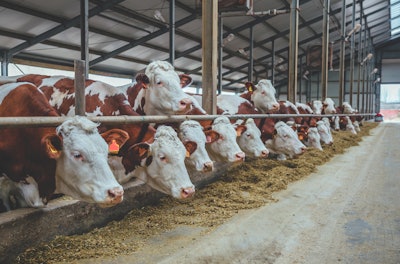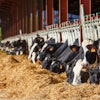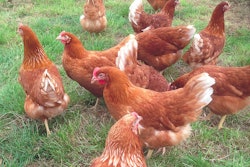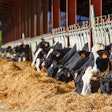
A review of the fundamental nutrition criteria for efficient dairy production
Nutritionists, producers, vets and other dairy professionals are well aware of the impact of nutrition, or more specifically, sub-optimal nutrition, on dairy cow productivity. There is a plethora of research, advanced ingredients and rationing tools to try to achieve optimal diets for different stages of the production cycle. A balanced dairy ration is crucial for promoting health and longevity, and is derived from carbohydrates, protein, minerals, vitamins and water — the compounds that drive metabolic processes in the body leading to growth, milk production and reproduction.
Energy and protein in dairy rations
Energy and protein are generally the first elements of a ration that are addressed. Energy is often the primary driver for milk yield and is often the first part of the ration to be tackled. Diets need to deliver sufficient energy to maintain yield, while, at the same time, ensure rumen function is not compromised.
2019 Dairy Outlook: Consumers, trade, weather sway dairy feed volumes
Carbohydrates (CHO) are the main source of energy in the diet, but lipids can also be used. In periods of energy deficit, the animal will also use carbon skeletons from amino acids. The use of dietary fat is well-established, but the level of fat in a ration is limited when compared with CHO. That said, fats, such as C16:0 and C18:0-based lipids, are used with success in dairy rations.
When putting together ruminant diets, carbohydrates are initially divided into two distinct categories: structural and non-structural. The former includes cellulose and hemicellulose that have a slow rumen fermentation rate and are primarily found in forages. The latter, such as starch and sugar, has a more rapid fermentation rate and is primarily found in cereal grains. The mix of these two broad categories within a diet is an important consideration given that it will influence nutrient supply and accretion based on the resultant volatile fatty acids (VFA) produced by bacterial fermentation of the glucose released following degradation of the CHO.
All CHO fermented within the rumen must pass through pyruvate before they are converted to their ultimate VFA end-product. Structural CHO tend to result in the production of acetate and butyrate, which are lipogenic in nature and are then converted to acetyl CoA in the liver, which then enters the Kreb’s Cycle. Conversely, full fermentation of non-structural CHO leads to the production of propionate, which is gluconeogenic and supplies around 50% of the animal’s glucose requirement.
The production of VFA drives a major portion of the energy within a ration. However, it will also impact milk composition as acetate drives milk fat. Increasing the efficiency with which dietary structural CHO are used can often yield a subsequent increment in milk fat.
Microbial protein
Dietary protein is linked to energy and, like energy, can be sub-divided into two categories: that which is susceptible to, and that which escapes, degradation in the rumen.
Microbes can hydrolyze proteins into small peptides and amino acids, some of which are used to generate organic acids, ammonia or carbon dioxide. Certain microbes, particularly cellulolytic bacteria, can fix non-protein nitrogen (NPN) and assimilate it into their body protein. This allows the ruminant to be able to utilize nitrogen sources non-ruminants cannot.
Bacterial ureases hydrolyze urea into ammonia and, providing sufficient energy sources are available, use it to generate microbial protein.
Ammonia is a key intermediate in nitrogen metabolism in the rumen and low levels result in slow microbial growth and poor CHO breakdown. In cases of nitrogen deficit, ammonia absorbed across the rumen wall may be converted to urea via the ornithine cycle in the liver and returned to the rumen via saliva. This recycling allows some control over rumen ammonia levels and recycled nitrogen can then be utilized as an NPN source to generate microbial protein.
As discussed, both energy and protein can each be subdivided into two categories and good rations will use an optimal mix of those categories. Microbial protein is the most cost-effective protein that a cow can utilize thus maximizing its production as a proportion of the protein supplied is a good goal. The efficiency with which microbial protein is produced is determined mainly by the form of nitrogen supplied and the balance of energy and nitrogen supplied.
 Minerals and vitamins influence many biological processes. Organic forms of trace minerals improve bioavailability with proven immunity and production benefits. (Vladimir Zapletin | iStock.com)
Minerals and vitamins influence many biological processes. Organic forms of trace minerals improve bioavailability with proven immunity and production benefits. (Vladimir Zapletin | iStock.com)Rumen synchrony
Thinking about the two categories of energy (rapidly and slowly fermented in the rumen) and how well they match the degradation rates of dietary protein supply is a key feature of the well-established concept of rumen synchrony. Different rates of degradation between carbohydrate and protein result in low efficiency of microbial protein.
Two strategies exist to drive energy and protein synchrony: 1) Increase levels of readily available energy and 2) decrease the protein solubility of the ration. Studies have shown greater proportions of amino acids reaching the small intestine when the solubility of forage protein has been reduced. However, this may be difficult to achieve on a practical level.
The alternative of increasing supply of rapidly fermentable energy is much more easily achieved. In some areas of the globe, dairy diets are based on forage high in rapidly soluble protein, such as grass and grass silage, and reducing the level of this protein fraction can prove difficult without negatively affecting dietary neutral detergent fiber (NDF) levels.
Ammonia is the main source of nitrogen utilized by many rumen bacteria, but levels of ammonia in the rumen naturally fluctuate throughout the day thus the microbes experience periods of deficiency and excess over a 24-hour period. This results in a low efficiency of microbial protein production.
Controlled release NPN sources are often used to attempt to stabilize rumen ammonia levels in an attempt to avoid the peaks and troughs in rumen ammonia concentration. The concept is to better balance nitrogen and CHO sources with the aim of a more efficient use of dietary nitrogen.
Minerals in dairy rations
Minerals may be required in smaller amounts than energy and protein but are another area of importance when formulating rations for dairy animals, particularly during the dry period.
The balance and supply of macro minerals, such as calcium, phosphorous and magnesium, are critical to reduce the risk of costly metabolic issues, such as milk fever.
There are a few options available when feeding the close-up dry cow to reduce the risk of milk fever. Methods include reliance on a diet low (<20 g/d) in calcium, feeding a ration with a negative cation-anion difference and on drenching the cow around parturition with a calcium bolus.
Traditionally, calcium restriction during the dry period has been common practice to try to trigger homeostatic regulatory mechanisms and reduce reliance on dietary calcium. One way to achieve this is the use of calcium binders, such as sodium aluminosilicate. Dietary inclusion of these binders has yielded positive results but, at certain levels, can substantially reduce feed intake and cause hypophosphatemia. Additionally, the cow will be lacking in calcium postpartum (hence the use of calcium boluses and injectables) and may have other detrimental effects. The recommended duration of feeding for such products range from one to three weeks prepartum. However, in reality, calcium restriction is only required two to three days prepartum.
In many areas, dietary potassium levels are unavoidably high during the dry period, which reduces magnesium absorption and, subsequently, negatively impacts calcium metabolism leading to hypocalcemia. Ensuring sufficient magnesium during the dry period is critical, especially when feeding high-potassium forages, such as grass silage and ~40g/h/d of added magnesium is required.
DCAD considerations
Dietary cation-anion difference (DCAD) is a system often employed to great effect during the close-up period. It works on the basis of acidifying the blood to stimulate the release of calcium and a negative DCAD value is preferable for dry cows. As with all dietary interventions, animals should be regularly monitored. Anionic salts are often used to reduce the DCAD and this can be measured by checking urine pH. If the DCAD is correct, then urine pH should be ~6.5; a pH of 9 indicates potential metabolic issues.
Minerals can, similar to their CHO and protein associates, be classified into two groups: macro and micro minerals, the difference being the amounts required by the animal. During the close-up period, cows can experience suppressed immune function and increased oxidative stress. It is well-accepted that selenium is a crucial antioxidant that works in tandem with vitamin E and has a major impact on oxidative stress. Adequate selenium status has a positive effect on the animal’s ability to resist infection, as well as fertility parameters.
Zinc is also well-known to have effects on immune function, as well as gene expression and appetite control. It is also part of a group of antioxidant molecules called superoxide dismutase (SOD). Inclusion in SOD is shared with copper and thus both these minerals have an antioxidant function. Copper also functions as a clotting agent and as part of cellular respiration. Manganese, too, is part of the antioxidant function, as well as playing a role in cartilage integrity and reproduction.
The transition period is a physiologically expensive time for a dairy cow, and it is easy to understand why mineral supply should be closely addressed.
Organic trace minerals
It is well-established that organic forms of minerals generally have higher bioavailability and retention in the body compared with their inorganic counterparts.
As selenium cannot be chelated, selenium-enriched yeast is often used to deliver selenium in an organic form. Significant improvements in immune call function have been noted when feeding selenium-enriched yeast compared with inorganic selenium. Positive effects have been noted with feeding an organic form of other minerals. Chelated zinc, copper and manganese have demonstrated increased milk and milk protein yield, as well as improved health and fertility status.
The total-tract trace mineral utilization and bioavailability of different forms of trace mineral were examined in a recent study. Despite a lower mineral intake for animals fed organic trace minerals, blood mineral levels were not different, suggesting enhanced absorption of the organic form over their inorganic counterparts.
Vitamin E is closely related to selenium in function and ensuring selenium-adequacy allows the reduction in dietary levels of Vitamin E. In terms of Vitamins A and D3, a rule of thumb ratio is given as 5:1 A:D3.
References available on request.















